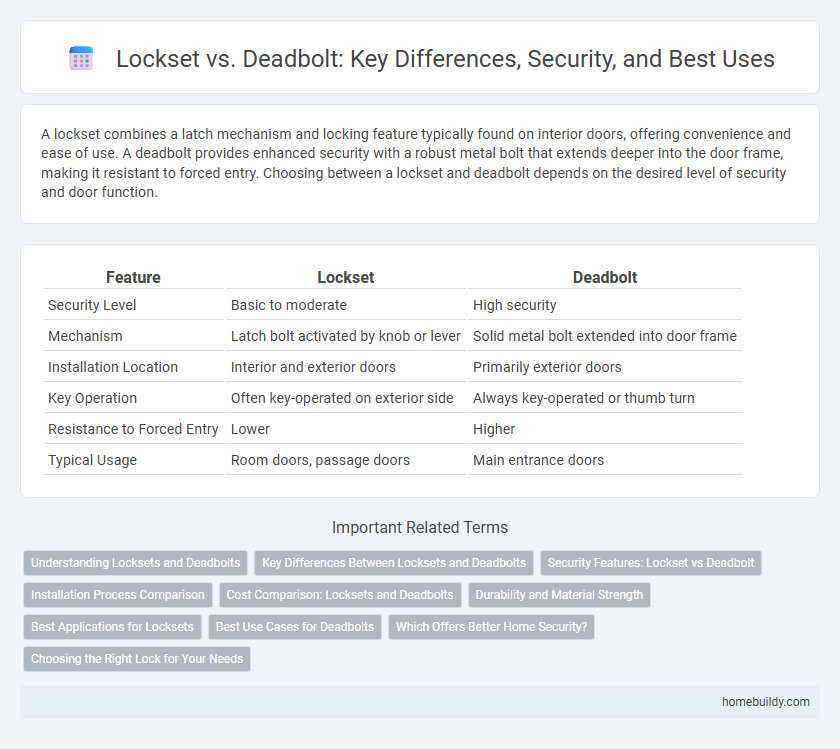A lockset combines a latch mechanism and locking feature typically found on interior doors, offering convenience and ease of use. A deadbolt provides enhanced security with a robust metal bolt that extends deeper into the door frame, making it resistant to forced entry. Choosing between a lockset and deadbolt depends on the desired level of security and door function.
Table of Comparison
| Feature | Lockset | Deadbolt |
|---|---|---|
| Security Level | Basic to moderate | High security |
| Mechanism | Latch bolt activated by knob or lever | Solid metal bolt extended into door frame |
| Installation Location | Interior and exterior doors | Primarily exterior doors |
| Key Operation | Often key-operated on exterior side | Always key-operated or thumb turn |
| Resistance to Forced Entry | Lower | Higher |
| Typical Usage | Room doors, passage doors | Main entrance doors |
Understanding Locksets and Deadbolts
Locksets combine a latch and a locking mechanism, typically operated by a key or thumb turn, offering convenience for interior doors and commonly used in residential settings. Deadbolts provide extra security by extending a solid metal bolt into the door frame, making them resistant to forced entry and preferred for exterior doors. Understanding the difference between locksets and deadbolts helps homeowners select appropriate hardware based on security needs and door location.
Key Differences Between Locksets and Deadbolts
Locksets combine a latch mechanism with a locking feature typically engaged by a knob or lever, providing convenience for interior doors, while deadbolts use a solid metal bolt extended deep into the door frame for enhanced security. Deadbolts offer higher resistance to forced entry due to their sturdy design, making them preferred for exterior doors where security is critical. The key difference lies in the locking mechanism; locksets rely on a spring latch, whereas deadbolts use a manually operated bolt that cannot be retracted without a key or thumb turn.
Security Features: Lockset vs Deadbolt
Deadbolts provide superior security through a solid metal bar that extends deep into the doorframe, making them highly resistant to forced entry and lock picking. Locksets typically combine a latch and lock in one mechanism, offering convenience but generally less resistance to physical attacks compared to deadbolts. For enhanced security, deadbolts are often recommended as a secondary locking mechanism alongside standard locksets.
Installation Process Comparison
Locksets typically offer simpler installation procedures, requiring only a standard door preparation with a single borehole, making them ideal for interior doors. Deadbolts demand more precise alignment and usually need additional reinforcement like a strike plate for enhanced security, which can extend installation time. Homeowners often find locksets easier and quicker to install, while deadbolts require more skill and tools to ensure proper functionality and durability.
Cost Comparison: Locksets and Deadbolts
Locksets typically cost between $15 and $50, making them a budget-friendly option for interior doors, while deadbolts range from $40 to $100, reflecting their enhanced security features for exterior doors. Installation costs also vary, with locksets easier and cheaper to install, often around $50, compared to deadbolts that may require professional installation costing up to $150. Choosing between locksets and deadbolts depends on balancing upfront expense and the level of security required for the specific door application.
Durability and Material Strength
Locksets typically feature spring-loaded latches made from brass or stainless steel, offering moderate durability suited for interior doors. Deadbolts are constructed with solid steel bolts and hardened metal components, providing superior material strength and resistance to forced entry. This enhanced durability makes deadbolts ideal for exterior doors requiring higher security levels.
Best Applications for Locksets
Locksets are best suited for interior doors within residential and commercial buildings, providing easy access and moderate security where convenience is prioritized. These locking mechanisms are ideal for bedrooms, bathrooms, and offices where quick entry and exit are necessary without sacrificing basic privacy. Unlike deadbolts that require keyed access, locksets offer functionality with privacy locks or passage functions, enhancing usability for high-traffic interior areas.
Best Use Cases for Deadbolts
Deadbolts provide superior security for exterior doors due to their hardened steel bolt, which extends deep into the door frame, making forced entry significantly more difficult compared to standard locksets. Ideal for front entrances, back doors, and any entry point requiring maximum protection, deadbolts resist picking and bumping better than traditional locksets. Residential and commercial properties benefit from deadbolts in high-crime areas or locations where enhanced security measures are prioritized.
Which Offers Better Home Security?
Deadbolt locks provide superior home security compared to standard locksets due to their solid metal bolt that extends deeper into the door frame, making forced entry more difficult. Locksets typically include a spring latch which can be more vulnerable to lock picking or jimmying. For maximum protection, combining a keyed deadbolt with a lockset on exterior doors offers enhanced resistance against break-ins.
Choosing the Right Lock for Your Needs
A lockset typically combines a latch and a lock, offering convenience and ease of use for interior doors, while a deadbolt provides enhanced security with a solid metal bolt extending into the door frame, ideal for exterior doors. Deadbolts are resistant to forced entry and pick attempts, making them a preferred choice for high-security needs, whereas locksets prioritize accessibility and quick locking. Selecting the right lock depends on balancing security requirements and functional use; exterior doors benefit from deadbolts, while interior doors often suffice with locksets.
Lockset vs Deadbolt Infographic

 homebuildy.com
homebuildy.com